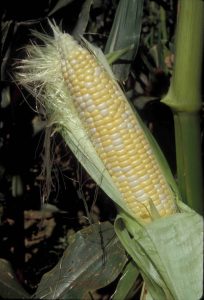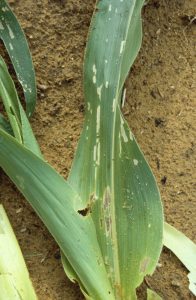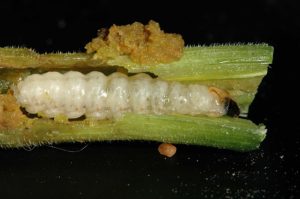Sweet Corn IPM Newsletter No. 5 – July 27, 2018
 Sweet Corn IPM Newsletter No. 5 – July 27, 2018
Sweet Corn IPM Newsletter No. 5 – July 27, 2018
Click on photos to enlarge.
CORN EARWORM NUMBERS CLIMBING
Populations Spotty, but Some Fields Severely Threatened
SITUATION
Corn harvest is coming into full swing for early varieties in southern and mid-coast farms. Warm weather has pushed maturity of later varieties, so we may see some concentration of maturity in the coming days. Warm air and rain coming up from the south over the past week has brought some corn earworm into the state, but not yet to the levels we expected. The warm air flow continues, however; so it is likely that pest pressure will increase in the coming days.

European corn borer: Activity in both pheromone traps and the fields remained very low this week. We did find pupae in stalks, which may indicate that we could see a second generation of corn borer this year that might threaten late corn. Moths were caught in Biddeford, Cape Elizabeth, Dayton, Lewiston, North Berwick, Oxford, and Wales. They were below threshold for silking corn at all of these sites. Feeding damage in the field was very light, with no sites over the 15% spray threshold for pre-tassel to silking corn.
Corn earworm: Numbers of moths caught in traps this week were quite variable and didn’t seem to follow any geographic pattern. A 6-day spray interval for all silking corn was recommended for our sites in Biddeford, Cape Elizabeth and Sabattus. A 5-day spray interval was recommended for Bowdoinham and Garland. A 4-day spray interval was recommended for a silking field in Levant. As the weather for the coming week is predicted to continue coming up from the south, we should expect corn earworm pressure to continue and be prepared to protect all silking corn.
Fall armyworm: No moths were caught in our pheromone traps this week, but we have found some larval feeding damage in the cornfields we’ve scouted. This is not unusual; our traps often don’t catch the first moths into the fields, so we see feeding injury before we see moths. No feeding injury was over the 15% spray threshold. We also continue to see a small amount of feeding injury from common army worm, but we expect these larvae to be pupating very soon. The anticipated weather pattern could bring a rapid increase in fall armyworm numbers in the coming days.
- Fall Armyworm Injury on Corn Leaves; photo by David Handley
- Squash Vine Borer Larva; photo by Jeffrey Hahn, Univ. of Minnesota Extension
Squash vine borer moths were caught in pheromone traps in Biddeford, Lewiston, Wells and Oxford. Only the Oxford site, which had 5 moths, was over the spray threshold. All other sites were below the spray threshold, Counts may still increase in the coming days, so growers should continue scouting for vine borer symptoms and protect squash plants if moths or damage are seen. See the 2018-2019 New England Vegetable Management Guide for control options.
Spotted wing drosophila: We continue to capture spotted wing drosophila (SWD) flies around the state, but still in relatively low numbers. We have had reports of larval infestation of unsprayed raspberry fruit, so growers who have been capturing flies in traps for more than one week should protect ripening fruit, if sprays have not yet been applied. For more information visit our SWD blog.
Sincerely,
David T. Handley
Vegetable and Small Fruit Specialist
Highmoor Farm, P.O. Box 179, 52 US Route 202, Monmouth, ME 04259, 207.933.2100
UMaine Extension Diagnostic Research Lab, Pest Management Unit, 17 Godfrey Drive, Orono, ME 04473, 1.800.287.0279
| Location | CEW Moths |
ECB Moths |
FAW Moths |
%Feeding Damage |
Recommendations / Comments |
|---|---|---|---|---|---|
| Biddeford | 3 | 3 | 0 | 0% | 6-day spray interval recommended on all silking corn |
| Bowdoinham | 4 | 0 | 0 | 0% | 5-day spray interval recommended on all silking corn |
| Cape Elizabeth I | 0 | 0 | 0 | 0% | No spray recommended |
| Cape Elizabeth II | 2 | 2 | 0 | – | 6-day spray interval recommended on all silking corn |
| Charleston | 0 | 0 | 0 | 0% | No spray recommended |
| Dayton I | 0 | 0 | 0 | 0% | No spray recommended |
| Dayton II | 0 | 2 | 0 | 2% | No spray recommended |
| Farmington | 0 | 0 | 0 | 0% | No spray recommended |
| Garland | 6 | 0 | 0 | 1% | 5-day spray interval recommended on all silking corn |
| Levant | 29 | 0 | 0 | 3% | 4-day spray interval recommended on all silking corn |
| Lewiston I | 0 | 0 | 0 | 0% | No spray recommended |
| Lewiston II | 1 | 1 | 0 | 0% | No spray recommended |
| New Gloucester | 0 | 0 | 0 | 0% | No spray recommended |
| No. Berwick | 0 | 1 | 0 | 3% | No spray recommended |
| Oxford | 1 | 1 | 0 | 3% | No spray recommended |
| Palmyra | 0 | 0 | 0 | 0% | No spray recommended |
| Poland | 1 | 0 | 0 | 2% | No spray recommended |
| Sabattus | 2 | 0 | 0 | 0% | 6-day spray interval recommended on all silking corn |
| Wales | 0 | 2 | 0 | 1% | No spray recommended |
| Wayne | 0 | 0 | 0 | 1% | No spray recommended |
| Wells I | 0 | 0 | 0 | 4% | No spray recommended |
| Wells II | 1 | 0 | 0 | 4% | No spray recommended |
CEW: Corn earworm (Only fresh silking corn should be sprayed for this insect.)
ECB: European corn borer
FAW: Fall armyworm
| Moths caught per week | Moths caught per night | Spray interval |
|---|---|---|
| 0.0 to 1.4 | 0.0 to 0.2 | No spray |
| 1.5 to 3.5 | 0.3 to 0.5 | Spray every 6 days |
| 3.6 to 7.0 | 0.6 to 1.0 | Spray every 5 days |
| 7.1 to 91 | 1.1 to 13.0 | Spray every 4 days |
| More than 91 | More than 13 | Spray every 3 days |
Thresholds apply only to corn with exposed fresh silk. Lengthen spray intervals by one day if maximum daily temperature is less than 80°F.
European Corn Borer Thresholds
Whorl stage: 30% or more of plants scouted show injury.
Pre-tassel-silk: 15% or more of plants scouted show injury.
Silk: 5 or more moths caught in pheromone traps in one week.
IPM Web Pages:
UMaine Cooperative Extension Integrated Pest Management
Penn State Pest Watch for Sweet Corn
UMass Amherst Integrated Pest Management
Where brand names or company names are used, it is for the reader’s information. No endorsement is implied nor is any discrimination intended against other products with similar ingredients. Always consult product labels for rates, application instructions and safety precautions. Users of these products assume all associated risks.
The University of Maine is an equal opportunity/affirmative action institution.


